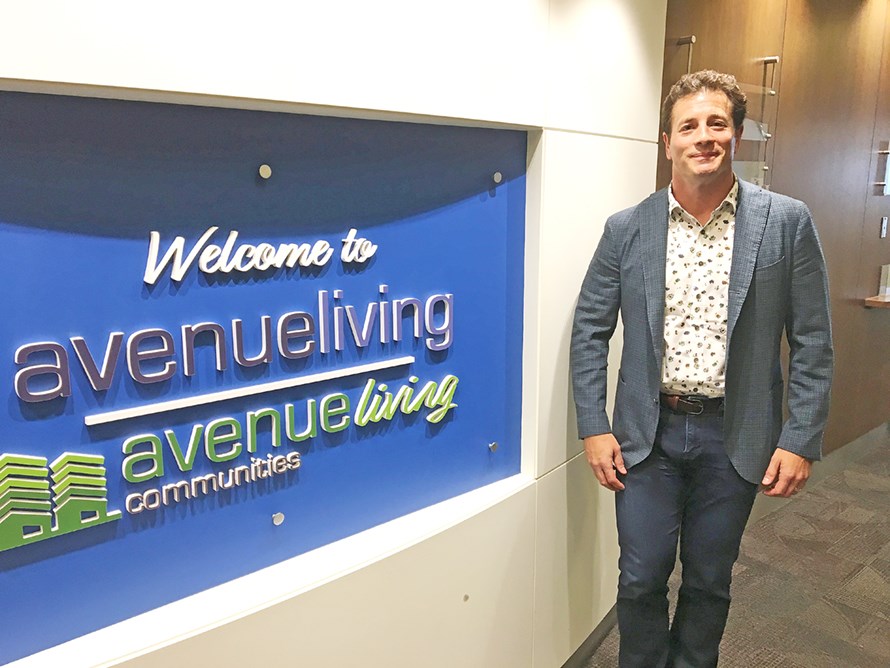In a seven-month period this year, Avenue Living Asset Management of Calgary raised $130 million, blowing past its forecast for the year and giving recognition to a homegrown Alberta investment company that has amassed $1.1 billion in assets in just 12 years.
The company had targeted on raising $75 million by the end of 2018, but what co-founder Anthony Giuffre calls “an accelerated capital injection” will put Avenue Living on an acquisition fast track. The capital growth came with the support of anchor investor Westcourt Capital and a number of smaller investors across its three different investment vehicles.
“We are already deploying the new capital,” Giuffre said, with the company both optimizing its balance sheet and sourcing new acquisition opportunities. Those include recent strategic buys in Calgary and smaller Alberta centres such as a 235-unit rental building in Red Deer.
Avenue Living was co-founded in 2006 by Giuffre, his brother Dr. Michael Giuffre and Carl Diodati. Its first purchase was a 24-unit residential rental building in Brooks, Alberta, for $3 million. This project set the tone for Avenue Living’s basic strategy: buy mid-level multi-family projects, improve the property through renovations and better management and raise the rents.
“We don’t like to sell,” Giuffre said, explaining Avenue Living has sold only one building since it started. “We chase yields.”
Today Avenue Living holds more than 320 buildings in its portfolio, including 7,350 residential rental units, 400,000 square feet of commercial space and 20,000 acres of Saskatchewan farmland. With the exception of a single 24-storey, 253-suite highrise in Winnipeg that it bought for $10 million and is upgrading, all of the company holdings are in Alberta and Saskatchewan and many of them in secondary markets.
That Avenue Living has accomplished what it has during two downturns – the industry-wide financial crisis of 2008 and the oil price collapse that cratered Alberta’s economy in 2014 – should be encouraging for other western investors.
Unlike many investors over the past few years, Giuffre looked to smaller Alberta centres for opportunities.
The “secret sauce,” he told Western Investor, is finding towns that are regional trading hubs and have a diversified economy and solid infrastructure. The type of towns, for instance, that may have already attracted a Walmart or a Costco. “Not a one-horse town,” he explained, that has its economy reliant on a single industry.
Alberta centres that fit the profile include Brooks, Red Deer, Medicine Hat and Lethbridge, where the company recently acquired two industrial properties. This year marked Avenue Living’s first acquisition in Calgary, with the purchase of an 80-unit multi-family rental complex.
It could prove prophetic. According to the Conference Board of Canada, Calgary’s 2017 GDP growth led major cities across the country at 4.6 per cent, and it is forecasted to regain a dominant position in economic growth between 2018 and 2021.
Noted Avison Young in a first-quarter report on Calgary’s multi-family rental market, “Improvement in rental demand has outpaced the number of new purpose-built rental units added to the market. As a result, the overall primary rental vacancy rate saw the largest annual decline in vacancy since 2010.”
Avenue Living is also active in the Saskatchewan cities of Saskatoon, Moose Jaw, Regina and Yorkton.
Despite Manitoba rent controls, Avenue Living would also look at opportunities in Brandon, Giuffre added.
When asked about British Columbia, he said parts of the B.C. Interior hold promise, but higher prices and stiff competition have so far kept Avenue Living east of the Rockies.
Avenue Living is more than a landlord. It has established three investment offerings with diversified investment strategies: Avenue Living Core Trust, an open-ended mutual fund trust targeting “stabilized assets with strong occupancy and stable current income.”; Avenue Living Opportunity Trust, a closed-ended mutual fund trust focussed on destabilized assets with value-add opportunities; and Avenue Living Agricultural Land Trust, a closed-ended mutual fund trust investing in agricultural land with a leaseback to farmers.
The privately held Avenue Living has in excess of $250 million in capital raised and is the custodian of more than $400 million in equity.
Avenue Living does not target portfolios in just any asset class, instead looking for mid-market rental buildings it can acquire for $90,000 to $130,000 per unit and upgrade to achieve higher income.
“That is how we do it,” Giuffre said from his Calgary office, “one building at a time.”
While hesitant to project future returns, he said historically Avenue Living has achieved annual returns for investors of 8 per cent to 12 per cent.



